
Question - What does one do during a lactate test?
- What does one do during lactate test?
- One day while we were at Kona for the Ironman World Championships, we set up a place to take lactate measures. A triathlete who wasn't competing came by and we took his lactate as he sat in a chair. We showed him the lactate reading and how easy it was to get an answer. He was very skeptical and asked us what did it mean. We told him that the answer really meant nothing because the lactate result only means something in the context of exercise**.
We then had him sit on a bicycle trainer and asked him to pedal at 100 watts for about 5 minutes. We then took his lactate reading again and it was almost the same as the reading when he was sitting in a chair. Again he asked what it meant and we told him that we had to increase the power to show him differences. In order to shorten the process, we asked him to pedal at 200 watts for five minutes. This is not a good way to do a proper lactate test but it shortened the process since we were interested in quickly showing him why lactate was a valuable measure.
It was still relatively easy for him but he was breathing a little bit harder. His lactate reading went up about 50%. We then asked him to pedal at 300 watts for 5 minutes. He couldn't finish the 5 minutes and the lactate reading was about 4 times the level at 100 watts. After a couple minutes we took another lactate reading and it was now even higher, about a third higher than it was just three minutes before and the athlete had been sitting all the time in a chair.
We then explained to him that lactate readings are mainly useful only in an exercise environment. Taking a lactate reading while sitting told us nearly nothing about his conditioning but taking a lactate reading after exercising at a specific exercise intensity told us a lot more. Certainly it did not tell us everything since the test we did was very imprecise and meant only to show the athlete how lactate varies depending upon the situation.
**There are times when a resting lactate can tell you a lot, especially if the person has additional resting lactate readings from other times. A subject for a future question.
- What do the results look like for a typical lactate test?
- There are several ways to do a lactate test and not all tests will provide the same information. The most common test is what is called a graded exercise test. An athlete starts the test at some relatively low level of effort, usually one that can be done easily.
Let's continue using cycling, with a relatively good cyclist and we will also collect heart rate information. The initial level is 180 watts. A less-conditioned cyclist may want to start at a lower level such as 100-150 watts. The lactate results at the initial steps are usually very similar to the lactate results taken while an athlete is at rest. After this initial step or stage as it is often called, the intensity level is raised. This is why it is called a graded test. For this example the power is raised 30 watts to 210 watts and the cyclist pedals again on his trainer for 3-5 minutes. The longer each stage in a lactate test, the more reliable the reading will be. This is because it takes time for the lactate to come to an equilibrium in the muscles before it levels off in the blood.
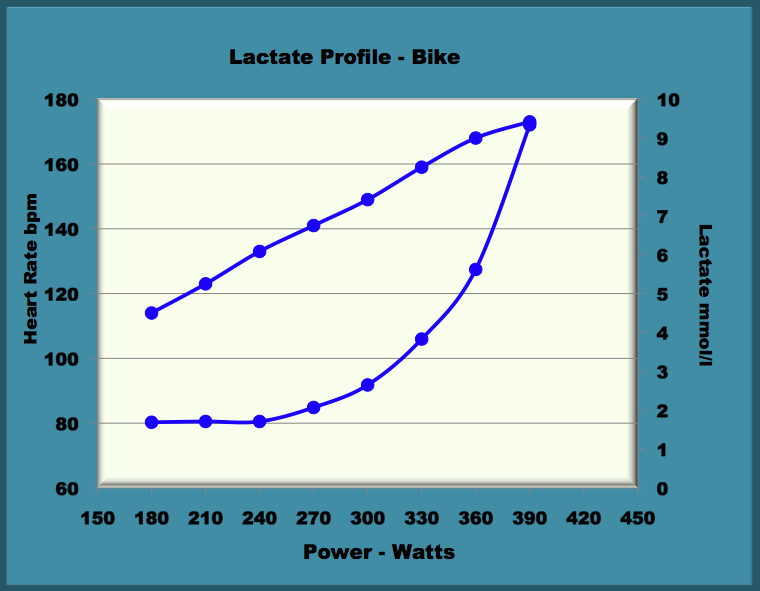
The lactate results are almost the same for this step at 210 watts and the next one at 240 watts. At 270 watts the curve rises a little. At each subsequent step the lactate levels are higher, and at 390 watts the athlete could not continue. Notice that the lactate results change very little at low levels and then suddenly shoot up. At the same time heart rate increases in a straight line. So what does all this mean? Further questions will address this as we try to understand just what is happening in the athlete's muscles.
- What causes the shape of the lactate curve?
- The above graph showed that the lactate curve behaves very differently than the heart rate curve. The following discussion may be a little hard to follow, but hopefully, we can make a complicated topic more understandable. We mean to show why knowing what is behind the lactate curve is essential to knowing how to reach an optimal conditioning level.
The lactate curve has been described as an exponential curve (not actually the case as will be discussed later) and the heart rate behaves essentially in a linear fashion. Let's look at a different combination of factors: lactate and oxygen consumption. The chart below is one of several we have for college soccer players. It compares oxygen consumption with lactate, while the subjects are running on a treadmill. The oxygen curve is essentially a straight line like the heart rate, while the lactate curve shows a curvilinear pattern. A resting lactate taken just before the exercise is indicated on the left hand side of the chart. The lactate levels were taken with the Lactate Scout.
One interesting thing about this curve is that the first couple of lactate readings are lower than the resting lactate value. This is not unusual and can be explained by the interactions of the different energy systems in the muscle cell and how lactate is actually consumed by the muscles. We will discuss in a later question just why in some circumstances lactate readings at easy exercise levels can be lower than resting lactates.
Again notice how the oxygen consumption increases in a linear fashion. Oxygen consumption increases from about 53% of VO2 max to about 80% of VO2 max and the lactate levels are only a little above the resting lactate levels. Then lactate climbs rapidly. So heart rate and oxygen consumption are linear and lactate is not. The lactate curve changes quickly as intensity gets higher and oxygen consumption becomes much higher.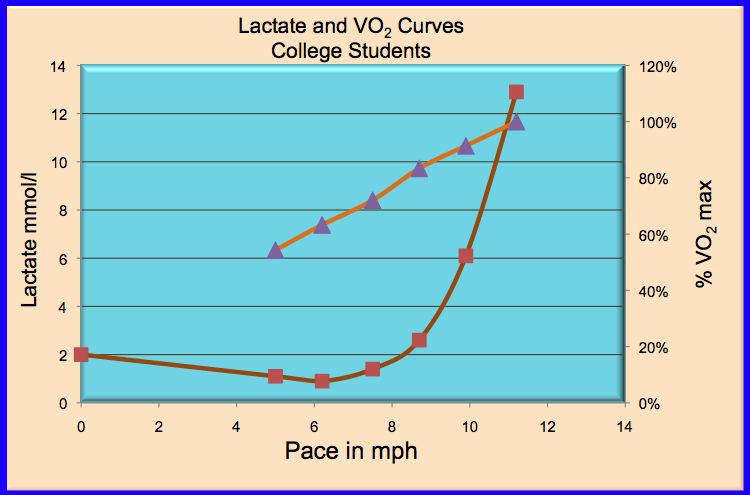
Why? Does it mean that the lactate is not being produced at low effort levels and is suddenly switched on at some point in large amounts? That is what a lot of scientists thought years ago but it turned out not to be true. Lactate is being produced as one sits and reads this web page and it has nothing to do with a lack of oxygen. Then why does it behave in the fashion we see on these charts.
The answer is twofold.
- First, lactate is the output of the anaerobic system and the main fuel of the aerobic system during exercise. So if lactate is being produced at low levels, it will never get to the bloodstream where it can be measured because it will be consumed by the aerobic system. The following figure is a simplified diagram of the energy metabolism process.
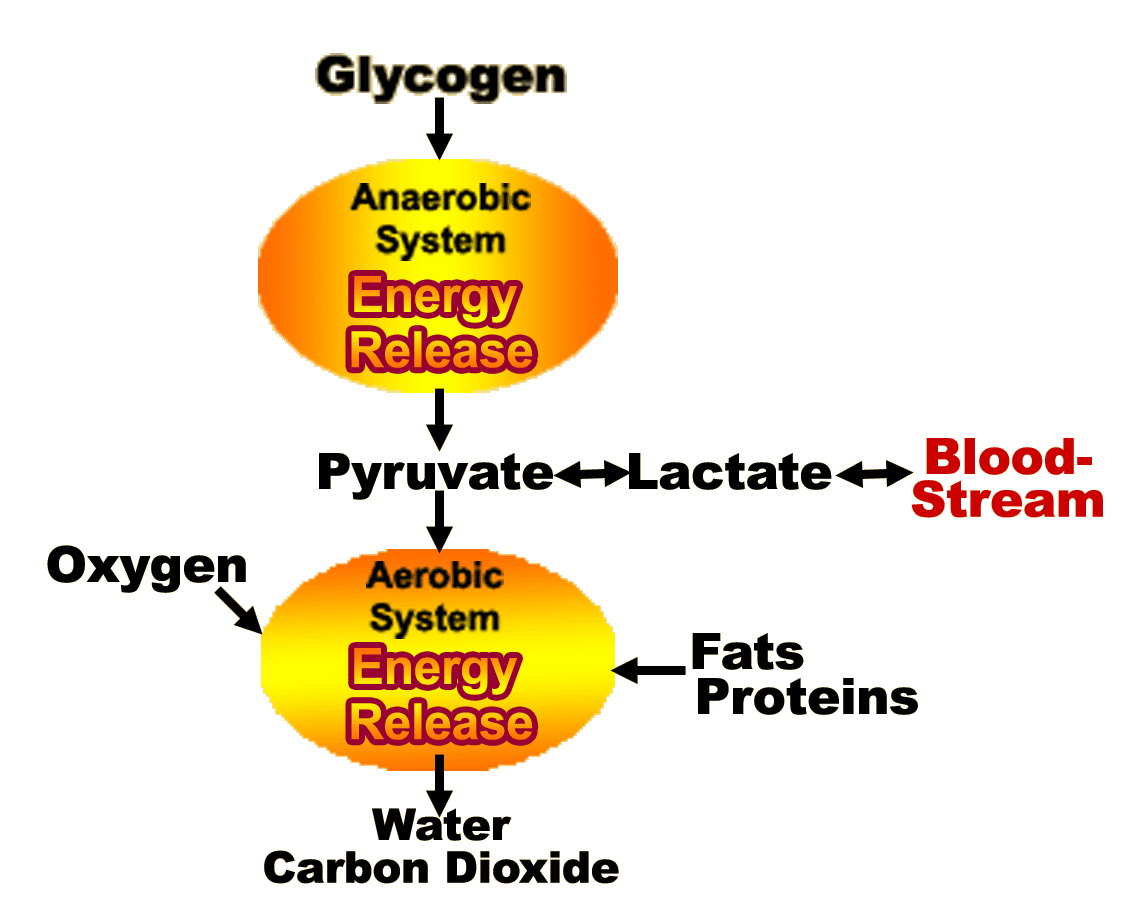
Diagram of basic aerobic and anaerobic energy producing processes
Notice two things.- (1) it is not lactate but pyruvate that is the output of the anaerobic system. But pyruvate is an intermediate step, which turns almost immediately into lactate.
- (2) lactate can enter the bloodstream or turn back into pyruvate. If lactate turns back into pyruvate, it will enter the aerobic system and be used as a fuel. There will be no change in the lactate levels in the bloodstream. So lactate is produced continually, but at low effort levels, most is immediately consumed by the muscles. The output of the aerobic system is energy, water and carbon dioxide; no change in blood lactate levels are noticed. Thus, at low levels a lot of the lactate produced never enters the blood stream. At higher exercise levels not all the lactate produced by the anaerobic system can be consumed by the originating muscles. Some will spill out into the bloodstream and the lactate levels in the bloodstream will rise.
- Second, lactate is the output of the anaerobic system. The output of the anaerobic system relative to the aerobic system is very low at low effort levels. As intensity increases, the anaerobic system gradually provides a higher percentage of energy. Thus, at low intensities very little lactate is produced but it increases very rapidly with exercise intensity. Here is a sample curve of lactate production in the muscles during exercise.
If you are familiar with lactate curves, this curve has a familiar shape. However, it differs from typical lactate curves in that it plots the rate of lactate production against VO2. It also shows the rate of lactate production in the muscles rather than in the bloodstream.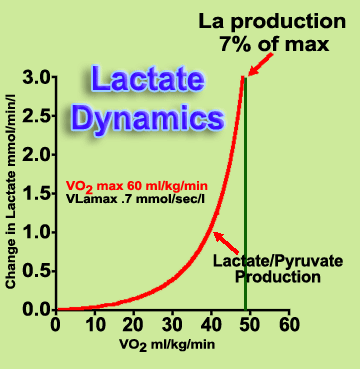
This curve is based on a model of energy production developed by Alois Mader, one of the most prominent scientists to study the relationship of lactate to athletic performance. Mader was originally part of the East German sports science establishment but escaped to West Germany in the early 1970's. He investigated the changes in the muscles as exercise intensity increased and found out the key factor was how the two energy systems interacted. Most researchers thought that the reason the anaerobic system rose in its contribution to the total energy needs of the athlete as energy requirements got higher was due to a lack of oxygen. Mader discovered a very different relationship that was due mainly to the relative strengths of each system. He found that the anaerobic system's involvement in producing energy was affected by the strength of the anaerobic system compared to the strength of the aerobic system. In other words the relative strength of the two systems is what determines how much of each is utilized, not the presence or absence of oxygen
It turns out that the rate of production of lactate is due to interactions between the two energy systems. The stronger one system is, the less the other is utilized during exercise. Or the converse is also true, the weaker one system is, the more the other will be utilized.
- First, lactate is the output of the anaerobic system and the main fuel of the aerobic system during exercise. So if lactate is being produced at low levels, it will never get to the bloodstream where it can be measured because it will be consumed by the aerobic system. The following figure is a simplified diagram of the energy metabolism process.
- What causes a particular lactate value?
- This question is a little vague because lactate levels vary from muscle cell to muscle cell and in different parts of the body at the same instant. So we have to specify what we mean by a particular lactate level. Do we mean the lactate in the blood or in the muscle? Do we mean the lactate taken from a fingertip or an earlobe or from a vein? We won't get too detailed here but leave a fuller explanation for later on. Right now, let's just look at the lactate level in the blood during exercise and ignore whether it is from a fingertip, earlobe or some other source. Just assume for this discussion that the sample comes from either the fingertip or the earlobe and during a continuous steady state exercise***.
During normal everyday activities, blood lactate levels vary, but not by much from one hour to the next. With strenuous exercise they go up; and if we lay in bed for an hour they might go down a little. Essentially the lactate level at any time would represent the result of normal biological processes that produce and eliminate lactate. At rest or low activity, lactate is mainly produced by the red blood cells and eliminated by aerobic processes as well as by the liver. A typical lactate level over the course of a 16-hour day without any strenuous activity would look like the following chart:
It fluctuates a little, but at rest the production of lactate Lp is much less than the processes that eliminate lactate Le. The average for this particular day is 1.44 mmol/l. During normal daily activity there is constant production and constant elimination. The difference between one time of the day and another is not totally understood, but some variance is due to food intake, which seems to affect lactate production. (The red blood cells are the only cells in the body that do not have mitochondria and thus all their energy is generated by anaerobic processes which produce lactate as an end result).
Most of the lactate is being eliminated or removed by the aerobic process in cells all over the body with some of the lactate being converted back into glucose in the liver. When one begins exercise, more lactate is produced than at rest so Lp increases. But the clearance processes Le continue to eliminate lactate from the system. So it sometimes looks like there is no change in blood lactate even though the body is producing more. Here are typical lactate values over a 30-minute period for different levels of exercise.
For the chart above Lp is increasing as the intensity of the exercise gets harder. Each line represents a slightly harder effort (from blue to red to green to purple to teal to brown). But for the first five effort levels, the elimination capability Le is equal to or higher than the production rate Lp. That is why each line represents a steady state. For the sixth level (brown line) Lp is greater than Le and the lactate levels continue to rise – there is no steady state. Eventually athletes have to stop at this effort level because of the increase of various metabolites which causes the muscles to get very acidic.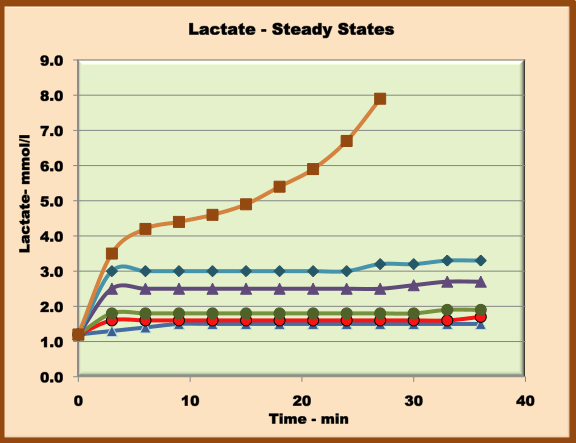
At rest and at low effort levels the lactate elimination processes are such that the lactate produced is mostly removed locally. Little if any lactate ever enters the bloodstream. If some lactate enters the bloodstream it is being taken out in equal amounts someplace else in the body. So there is little or no increase in observed lactate levels in the bloodstream. In other words the Le elimination rate is much higher than the lactate production rate Lp. In the chart below is a typical graded lactate test. The first part of this curve is flat and is often referred to as the baseline. Lp is increasing but not enough to affect the blood lactate levels. If one could actually measure lactate in the muscles, the results would show small increasing levels of lactate even though the levels in the blood have not risen.
From 180-240 watts there is little or no change in blood lactate levels which are similar to resting levels for this particular athlete. At these effort levels Le is still much greater than Lp and the body gets rid of all the new lactate being produced.
At 270 and 300 watts Lp is even higher but still Le can keep it at a steady state but now the lactate level is higher than the baseline. Lp has increased significantly and causes the lactate in the blood to rise but Le can still remove an equivalent amount. The exercise is still steady state but blood lactate is now higher. Eventually the elimination rate cannot keep up with production and lactate levels rise rapidly in the blood.
The following chart is based on a simulation program that predicts several metabolic variables. In this chart muscle lactate is shown by the green line, while the blood lactate line is yellow. Notice how blood lactate lags lactate levels in the muscles. Muscle lactate indicates how much lactate is being produced Lp but even while still in the muscle, some of the lactate is used immediately as a fuel. The blood lactate is a net of production Lp minus elimination Le, much of which happens in other places in the body.
The next chart shows what would happen to lactate in the blood if the athlete changed the effort level every 6 minutes. The athlete would change from one steady state to a higher one every 6 minutes but eventually reach a point above any steady state.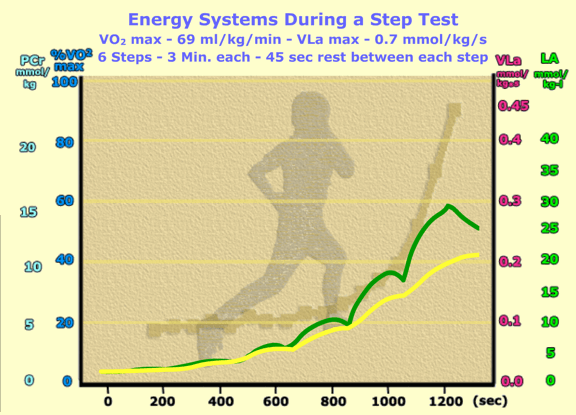
We have simplified the process by pointing out that a lactate value is just the result of two natural processes, lactate production Lp and lactate elimination Le. Now let's look at two lactate tests taken with the same athlete at two different time periods.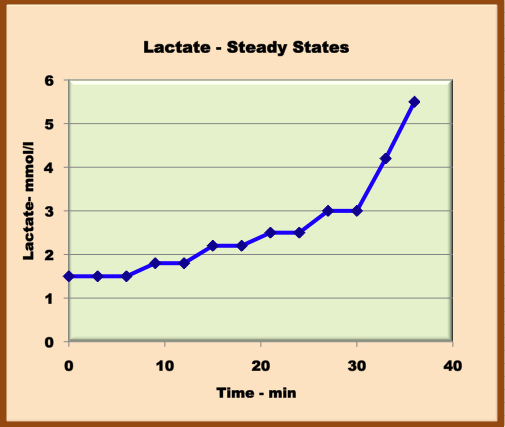
The early and late season tests are very similar at the first five low effort levels. But the next three readings show substantial divergence. We know from above that the lactate value is the net result of the elimination Le and production Lp processes. So which is it? Or could both have changed? We know that at least one of the two processes has changed. If this is an endurance athlete, it is a change that will let the athlete compete at a faster pace most of the time. But why do the muscles produce less lactate or eliminate more, later in the season? The answer to this is the secret of training and the main reason an athlete spends so much time working out.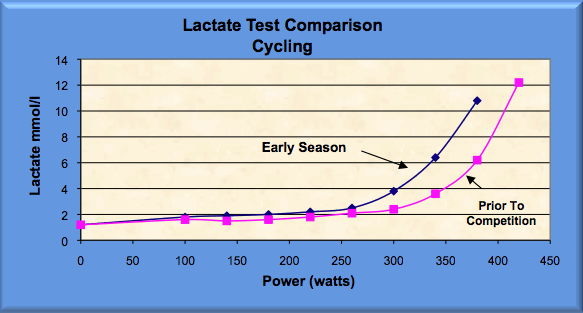
Before we go on to another question, let's look at the diagram above on energy metabolism but this time note the lactate production Lp and lactate elimination Le.
This illustrates that lactate production and lactate elimination are essential parts of energy metabolism and shows why the measurement of lactate is so important. Lactate values demonstrate how well the two energy systems are developed. This will be the greatest determinant of race performance. So lactate is the key to understanding how well the athlete is conditioned for a particular event.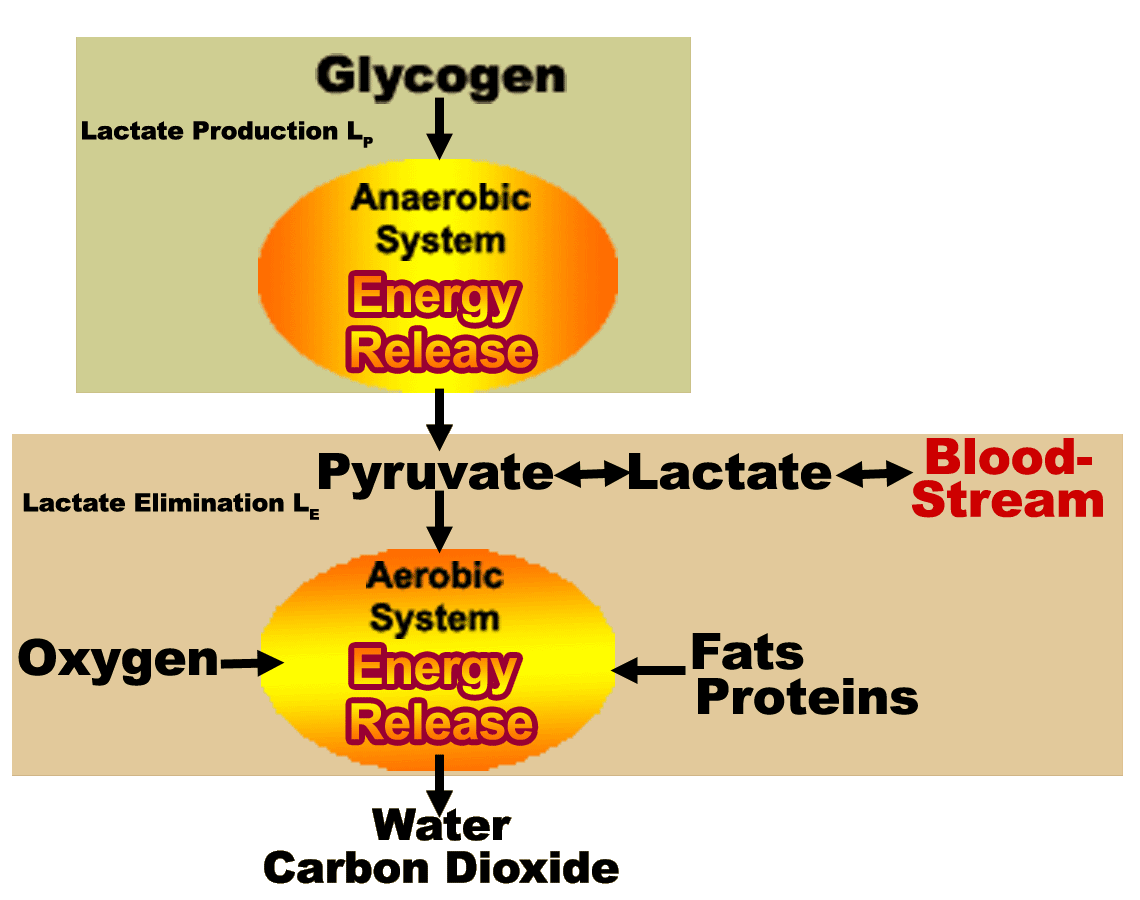
Why for a particular event? The reason is that at a particular moment an athlete may be optimally conditioned for one event but not another. For example, two runners with equal VO2 max's may not be able to perform equally well in the same event. One may excel in a marathon while the other would beat this runner handily at 1500 m. Lactate metabolism is key to understanding just why this is so.
***Steady state exercise are those intensities that are below the maximal lactate steady state. Lactate levels, heart rates, VO2 consumption and perceived effort change only small amounts over a time period, usually at least 50 minutes and sometimes much longer.